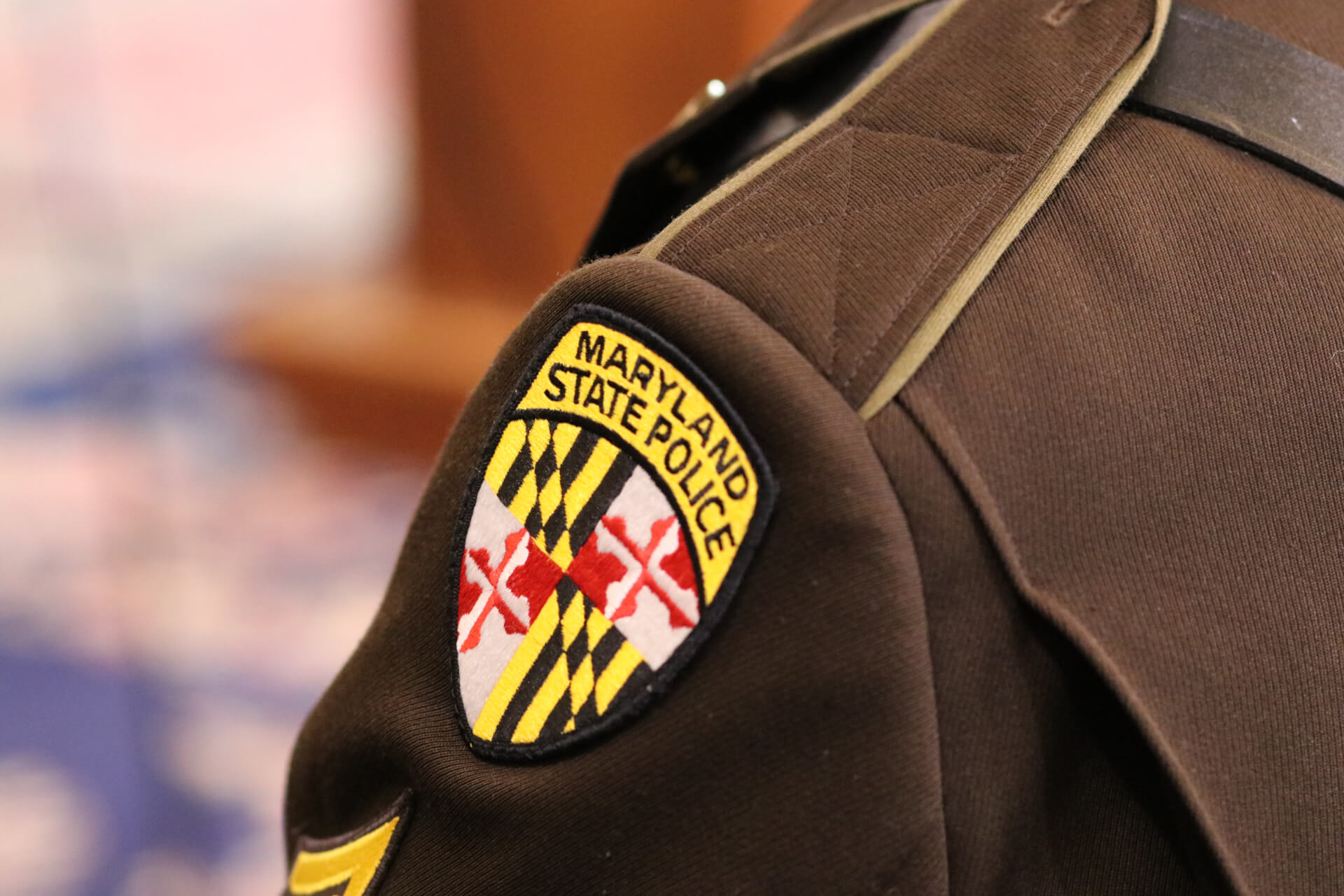National Policing Experts Preach Reform for Md.

John Feggins, Oct. 30, 2019, Baltimore Police.
Cody Ethan Mitchell, July 10, 2017, Howard County Police.
Reno Joseph Owens Jr., March 24, 2017, Baltimore Police.
Jose Alvarez, Sept. 17, 2018, Prince George’s County Police.
Chelsea M. Porter, Oct. 25, 2016, Maryland State Police.
Anton G. Black Jr., Sept 15, 2018, Greensboro Police.
Briatay McDuffie, July 22, 2014, Baltimore County Police.
Abraham Arellano, March 25, 2019, Frederick County Sheriff’s Office.
Korryn Gaines, Aug. 1, 2016, Baltimore County Police.
Christopher Stirkens, Jan. 29, 2014, Montgomery County Police.
These are just 10 of 128 people killed by Maryland police officers between 2013 and 2019.
Maryland officers are accountable for just 1.7% of total police killings across the U.S. during the same time period.
“This issue hasn’t substantially gotten worse, with regard to fatal police violence, since 2013,” Samuel Sinyangwe, co-founder of Campaign Zero and Mapping Police Violence, told members of the House Workgroup to Address Police Reform and Accountability in Maryland on Thursday.
“It also hasn’t gotten better.”
In the six years since the death of Michael Brown at the hands of police in Ferguson, Mo., Sinyangwe’s organization has tracked civilian deaths involving the use of force. These include shootings, beatings, restraints, the intentional weaponization of vehicles, and deaths resulting from the use of tasers and pepper spray by both on- and off-duty police officers, which Sinyangwe said until after Brown’s death was not tracked “federally or by any other form of government.”
According to the database, police have consistently killed between 1,000 and 1,150 civilians in the U.S. every year since 2013.
In 2019, there were only 27 calendar days where no police killings occurred. Most of the other 338 days averaged between two and three slayings.
Since the start of 2020, 598 people have died at the hands of the police, which Sinyangwe said is more in a six-month period than “for any prior year that we track, going all the way back to 2013.”
In 99% of police killings, no officers are charged. Sinyangwe said that even when officers are convicted, they often receive lesser sentences than civilians who perpetrate the same crimes.
“So functionally, the criminal justice system just does not hold officers accountable in almost any case,” he told lawmakers.
Map of U.S. police killings in 2019 via mappingpoliceviolence.org
While police-involved civilian deaths have essentially stabilized, Sinyangwe explained to legislators that the locales have changed.
In urban areas, he said, police killings have gone down — by up to 37% in the 30 largest cities in the U.S. But in suburban and rural communities these incidents have increased.
“What that means is, while cities — large cities — have started to take some actions — have started to implement some changes to their use of force standards, to their enforcement of low-level offenses and marijuana possession … many of those changes have yet to be scaled by rural and suburban communities,” he explained. “So the role of state legislation is essentially to take what is working in some places and then scale that — through state legislation — across the board so that those reductions can be felt statewide.”
Sinyangwe also debunked the narrative that high rates of violent crime correspond to levels of police violence. For example, Detroit, which according to the Mapping Police Violence database has an average of just under 20 instances of violent crime per 1,000 residents, has an average of a little over two police-related deaths per 1,000 residents.
Per the same dataset, Baltimore City has a violent crime rate of around 11 incidents per 1,000 residents and a police killing rate of nearly 14.
Sinyangwe said in examining these disparate rates, it comes down to an analysis of the policies and culture ingrained in individual departments. So in order to address systemic police violence, policymakers must limit the ability of police departments to cause harm and reduce the officers’ roles in communities — “consistent with calls to defund the police.”
‘Contact trace’ police violence
Following the 2020 deaths of Breonna Taylor and George Floyd at the hands of police, many policymakers and advocates across the state have called for a repeal of the Maryland Law Enforcement Officer’s Bill of Rights, which offers certain protections to members of the police force during misconduct investigations.
Maryland is one of 15 states that still has a Law Enforcement Officer’s Bill of Rights.
Sinyangwe said these protections make it “more difficult” to hold officers accountable. For example, under Maryland’s Law Enforcement Officer’s Bill of Rights, police officers’ formal complaint records can be expunged if the charges were unsubstantiated, if they were exonerated or if it has been at least three years since the final disposition.
He told workgroup members that when analysts can access police records, they can “contact trace” police violence using epidemiological models, pointing to the Chicago Police Department as an example.
Analysts who combed through 17 years’ worth of police fatal and non-fatal use of force records, sustained and unsustained misconduct allegations and lawsuits levied against police officers — including names and personnel files — found 1,300 of 30,000 officers with consistent misconduct complaints, adding that when officers work in close proximity to others with high rates of misconduct, those officers are five times more likely to use force and six times more likely to discharge their firearms down the line.
He said that these models can allow policymakers to rethink early intervention systems and remove those officers before they impact the behavior of others.
“All of that requires the data. It requires it not being confidential,” Sinyangwe asserted. “It requires the ability of police chiefs and oversight structures to hold those officers accountable — to remove them from the force without them then getting re-instated because of a variety of different processes and Law Enforcement Officer’s Bill of Rights laws and police union contracts.”
He did concede that Maryland has implemented a data collection policy surrounding the use of force under an amended version of the Law Enforcement Officer’s Bill of Rights, but said that many agencies haven’t complied and those that did collect scant information, which he called “not very helpful.”
Sinyangwe said that because, nationally, 93% of police misconduct cases are dismissed, Maryland officers have their files wiped clean after three years, and this “contact tracing” seen in Chicago can’t occur.
“Under this police Bill of Rights law in Maryland, the vast majority of evidence that would be needed to establish these patterns — to intervene and remove officers from the force with the biggest records of misconduct — that evidence is being systematically purged because of state law,” he said.
There are currently 13 states where both sustained and non-sustained police misconduct records are publicly available. New York recently repealed 50-a — the state law that formerly protected police misconduct records from public inspection.
“If it’s good enough for Florida or Alabama or Georgia or Connecticut or Maine or Ohio, there’s no reason it can’t be good enough for Maryland, as well,” Sinyangwe said.
Amber Widgery, a senior policy specialist at the National Conference of State Legislatures told lawmakers that since May 25 — the day George Floyd was suffocated by a Minneapolis police officer — 27 states and Washington, D.C., have introduced 339 pieces of policing-related legislation. Thirty-five of these bills have been enacted.
These laws include convening workgroups, reporting data, addressing use of force policies and officers’ duty to intervene, frameworks for independent misconduct investigations, body-worn camera policies and firmer guidance for officer training.
“Without COVID-19-related session delays and recess, only 17 states would have normally been in session after the events on May 25,” she said, meaning several states convened special sessions.
Widgery noted, specifically, that Oregon and Minnesota convened sessions with the intent of taking up both COVID-19 and policing related legislation.
Since General Assembly leadership has not called a special session, Maryland lawmakers are limited in their ability to legislate at this time. Lawmakers have pleaded with Gov. Lawrence J. Hogan Jr. (R) to take action through an executive order, but he has not indicated that he will issue one.
Sinyangwe pointed to other flaws in the Law Enforcement Officer’s Bill of Rights, including the five-day waiting period before officers are allowed to be interrogated after an instance of misconduct, which he said allows officers to review evidence and “get their story straight” — a privilege civilians don’t possess.
He explained that legislation with the strongest evidence to enforce positive change surrounds accountability, including repealing Law Enforcement Officer’s Bill of Rights laws and similar provisions in police union contracts. He cited a law enacted in Connecticut in 2015 disallowing the re-hire of officers who were fired or resigned while under investigation.
“So what this does is it addresses this issue of officers sort of cycling through agencies even if they have these records of misconduct, and instead says ‘If you committed this misconduct or resigned under investigation for a whole variety of classes of misconduct … you cannot be rehired in the state,’” Sinyangwe said.
Laurie O. Robinson, who served on the Obama administration’s White House Task Force on 21st Century Policing following Brown’s death in Missouri told the workgroup that in their final recommendations, the panel determined that independent investigations — and prosecutions — of officer misconduct are necessary.
“We felt that in order to be credible to the public, which is often skeptical, of course, an agency cannot investigate itself, and that the credibility of the justice system and the appearance of justice really require an unbiased arbiter,” she said.
Asked if police officers would still undergo due process should the Law Enforcement Officer’s Bill of Rights be repealed, Sinyangwe said yes.
“The police would be like every other civil servant and have access to those protections, and it would put Maryland in line with the 35 states that don’t have LEOBR, so I think this argument that you need the LEOBR in order to have due process protections for officers … that’s not true unless you believe that none of those other states’ officers have due process protections,” he said.





 Creative Commons Attribution
Creative Commons Attribution